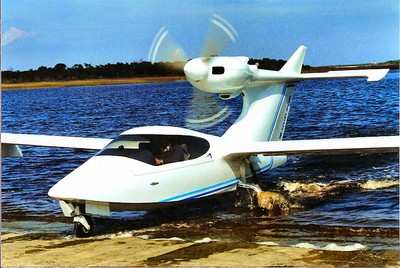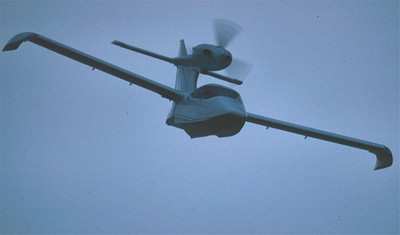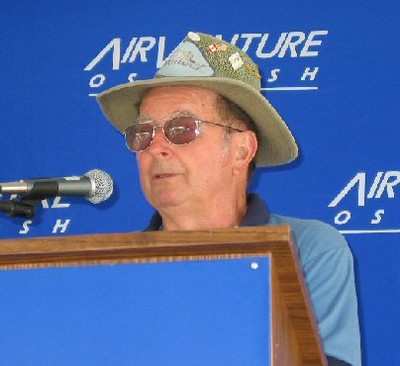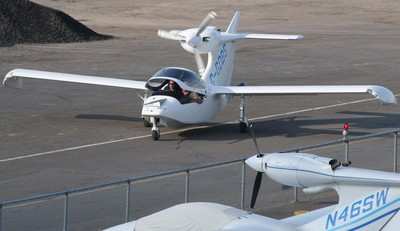Witness Heard Engine 'Sputter,' Saw Plane Spiral
Down
The pilot of a Seawind 300C test aircraft, one of those used in
Seawinds certification program, who died Thursday in an accident
near Winnipeg's St. Andrews Airport has been identified.

Glenn Ralph Holmes, 67, had been involved in the flight test
program for the four-place amphibian for about a year.
"He passed away doing what he loved to do," Liz Holmes told the
Winnipeg Free Press. "He has been flying for over 40 years -- he
was a bush pilot before this. He was at the epitome of his career
doing what he loved."
As ANN reported Thursday, the
lone witness to the accident said she heard an aircraft flying
overhead with its engine "sputtering," before the noise
stopped.
"Then it just quit. The motor quit. The engine quit, and then it
kind of glided a little bit," Darlene Steffan told the Thunder Bay
Chronicle Journal. "Then it just turned straight down, the nose,
and then started spiralling. I lost sight of it behind the trees
(and) about two seconds later I heard a sickening thuck."

Emergency crews were at the scene of the accident within 20
minutes, according to Steffan. The aircraft came down in a heavily
wooded area near the town of Stead.
The aircraft did not catch fire, according to a RCMP officer,
and the wreckage was confined to about a 30-foot radius. Reported
weather conditions were clear skies, with a 10-knot wind and
temperature of 63 degrees F.
Seawind History
The Seawind seats four adults under its clamshell canopy, or two
with a significant amount of luggage. Useful load of about 1100
pounds is divided among fuel load and passengers, luggage, and
cargo. With a 310-horsepower Continental IO-550-N, the aircraft
cruises at 166 knots, according to the company.
Seawind builder Len Carlson told the Free Press he has flown his
aircraft for 10 years. "It's a fairly rare plane in the world,"
Carlson said Thursday. "It's a good plane and we've had phenomenal
use with it -- we've flown it to the Arctic and to Wisconsin. You
can go anyplace with it."
In 2003 -- after roughly 150 kits had been sold over 10 years,
with anywhere from 50 to 75 planes flying, depending on your source
-- the company announced plans to certify the Seawind in Canada as
the 300C, with FAA certification to follow. The company had hoped
to have certified planes in customers' hands by late 2004, but that
date slipped due to funding issues and required changes to the
design... including, in one unusual case, needing to weaken the
aircraft's seats to better absorb vertical impacts.

Last month at AirVenture 2007, company president Richard Silva
(above) told ANN the 300C needed only to complete spin testing
to receive its oft-delayed VFR Type Certificate from Transport
Canada and the FAA. Silva added that was proving somewhat
difficult, as the company's test pilot had so far been unable to
get more than an entry into a spiral.
It is not known whether those tests were underway at the time of
Thursday's accident.
Accident History
A search of the National Transportation Safety Board aviation
accident database lists 13 accidents involving customer-built
Seawinds since 1993. Six of those accidents were fatal, claiming 10
people. A significant number of those accidents were attributed to
engine failure, either due to mechanical failure or pilot error (in
three accidents, the cause of engine failure was undetermined.)

Two accidents were attributed to VFR pilots continuing flight
into instrument conditions.
 ANN's Daily Aero-Term (11.14.25): Marker Beacon
ANN's Daily Aero-Term (11.14.25): Marker Beacon Aero-News: Quote of the Day (11.14.25)
Aero-News: Quote of the Day (11.14.25) Classic Aero-TV: CiES All-Digital Fuel Senders
Classic Aero-TV: CiES All-Digital Fuel Senders Airborne 11.10.25: Affordable Expo Succeeds, Citation Ascend, Kenai Shuts Down
Airborne 11.10.25: Affordable Expo Succeeds, Citation Ascend, Kenai Shuts Down NTSB Final Report: Lancair 320
NTSB Final Report: Lancair 320






